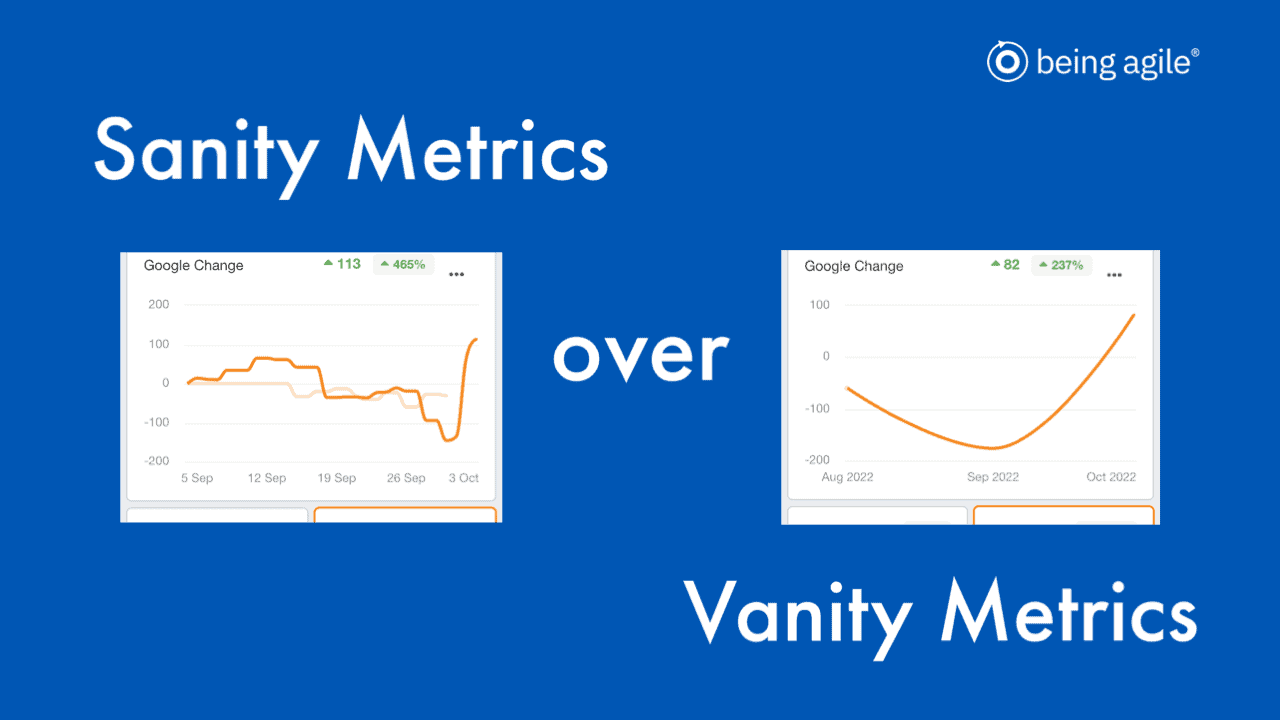
A lovely example has just popped up in my seo report, same data, slightly different views.
One shows me what I need to know to improve, a great sanity metric of the reality of the ups and downs!
The other makes me feel better a great vanity metric. A lovely graph averaging things out into a hockey stick curve, it looks great!
Graphs often smooth things out into nice bell curves, hockey sticks, and straight lines but they show the averages, not the actual reality of the journey taken! #sanitymetrics #vanitymetrics #metrics #beingagile
This is a quick chat about sanity metrics over vanity metrics.
It’s something that I’ve talked about for quite a long time, it’s in the book, and people often ask what do I mean by it. What I mean is when we think about the metrics that we’re developing within our businesses within our organizations for our teams, for our stakeholders, for our investors, that we can think about what kind of metrics they are.
By vanity metrics what I mean is they are the numbers that you show to your investors, that you show to your committee, to your manager, to show them that things are going well. So they are the vanity metrics, the things are going well and they paint a good picture of how things are going.
We are on track, so we show the numbers that give the best impression if you like, and perhaps hide those numbers that that might bring about questions. We call them Vanity metrics because they are very much about protecting our own vanity in terms of yes everything’s going fine, it’s absolutely great and wonderful, and it’s all good.
Whereas sanity metrics are the metrics that actually tell us what we need to know. These are the metrics that tell us the things that we can use to improve and do better, and so agile is a really great example of this, where we literally put the writing on the wall. So we’re putting the writing on the wall, we’re tracking the status of those tasks, on whether it’s post-it notes or digital tasks task notes, and we’re showing that progress.
We can visibly see, so we can show what is happening and we can respond to that. So that is a sanity metric for us we can see where things are getting stuck in waiting.
So the sanity metrics that we need are the ones that tell the team you know, yes, what going well, but also what could be better. Notice those subtle changes that often can only be identified by the team that they don’t always show up immediately in the numbers so we might see patterns in numbers but it might be you know instinct and intuition of our of our team members that identify this early on and and we can use that and keep track of that so that we can spot issues or opportunities really early and respond to those.
I’m not suggesting that we shouldn’t have vanity metrics you know there is a time and place for them and we absolutely should have them but we should value our sanity metrics over those vanity metrics and because the vanity metrics only paint part of the picture the picture that we want to see whereas our sanity metrics that complete picture.
These might just be for our own internal use, we might not share them with the world, but they’re really helping to tell us what we need to know. So many of those metrics can be gleaned by taking an agile approach and so using the tools and the methods within agile and to really help us to understand our flow, our balance of work, our direction, what’s going well, what could be better, and really help give us some of those sanity metrics to help us to to to manage the change and uncertainty and find the opportunity and find the successful way forward
I’m Belinda, that was my take on science over vanity metrics. I hope you enjoyed it and if you’d like to hear more then please do subscribe to the channel and if you’d like to talk about your own business and team in particular areas your own metrics for example then please do get in touch and we can chat more about live sessions thanks for watching and I’ll see you again soon.